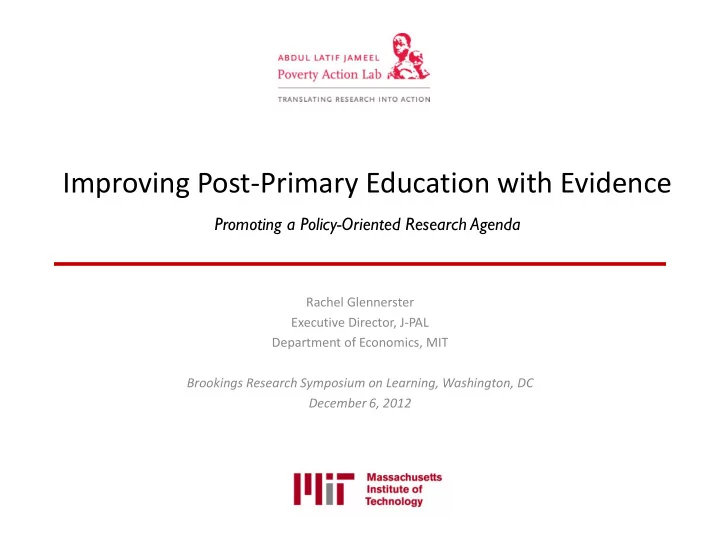

Improving Post-Primary Education with Evidence Promoting a Policy-Oriented Research Agenda Rachel Glennerster Executive Director, J-PAL Department of Economics, MIT Brookings Research Symposium on Learning, Washington, DC December 6, 2012
J-PAL Research in Education Network of 72 academics doing RCTs and working to influence policy 82 RCTs on education: important lessons for primary education Big gaps in evidence on secondary, the next big challenge in research and policy 2
The Post-Primary Challenge: Rising Expectations Primary: Converging on Universal Enrollment 140 120 Gross Primary Enrollment, Percent LAC - Girls 100 LAC - Boys E. Asia - Girls 80 E. Asia - Boys MENA - Girls 60 MENA - Boys South Asia - Girls South Asia - Boys 40 SSA -Girls SSA - Boys 20 0 3
The Post Primary Challenge: Learning Low learning levels at start and end of secondary school Disappointing learning outcomes in many countries that have made big investments in secondary education Inheriting poor learning levels from primary eg ASER (India) and UWEZO (East Africa) show most children not up to grade level in literacy, mathematics Qualified instructors hard to find Few in the previous generation completed secondary school Most secondary systems designed for small elite Often very expensive relative to primary, highly selective, often boarding schools Relevance of curriculum, especially for new mass intake? 5
Findings from J- PAL’s PPE Literature Review: Demand Enrollment sensitive to costs of schooling, borrowing constraints, and incentives (e.g. CCTs) RCTs have shown that small changes in CCT design can increase bang for the buck (e.g. changes in timing of payments) Students often misinformed about benefits of schooling, but complete more school when given accurate information about opportunities In vocational education, information about wages in different occupations can change choice of training women enter more lucrative, typically male dominated, trades 6
Findings from J- PAL’s PPE Literature Review: Supply Incomplete and inconclusive evidence on how to provide quality, relevant education Public vs. private: selection issues make role of private schools very hard to evaluate: Promising results from Colombia voucher study: do these results hold elsewhere and what about impact on public schools? Selective schools: natural regression discontinuity so many studies. Return to going to an elite school relatively modest ICT: mixed evidence; often not well integrated into a relevant curriculum Pedagogy: almost no evidence, primary example suggests this is critical, but do the lessons from primary translate to secondary? 7
Promising Ideas from Evidence on Primary Class size and inputs less important than pedagogy Teaching at the right level for the student has big returns ICTs Tracking Remedial education Accountability of teachers is critical, but incentives need to be crafted carefully Important interactions between health and education (eg deworming). Does this hold at later ages? 8
Additional Open Policy Questions Pedagogy What’s the right mix of theoretical vs. practical knowledge? Language of instruction? Is ICT more important in post primary? Vocational and private schools What mix of classroom vs. hands-on training? How should private sector be encouraged and/or regulated? 9
Additional Open Policy Questions Teacher and School Performance How best to train and incentivize teachers? Measurement tools to track student, teacher, and school performance Is parental oversight harder at post primary? Demand-side Interventions Optimal design of CCTs Testing scalable versions of information interventions How to reach kids who have already dropped out? Is the answer different for boys and girls? 10
Filling the Knowledge Gap Accumulation of RCT’s testing a range of programs in primary has given us a much better understanding of the drivers of quantity and quality at primary level. Also led to important policy changes Post Primary Education Initiative designed to systematically fill the gap on secondary education Review of what we know what we don’t (supported by MacAuthur and Marshall foundations) Set out key general questions Fund best studies to fill the knowledge gaps Coordinated outreach on research findings Similar initiatives in Agricultural Technology Adoption, Governance, and Sanitation 11
Thank You! For information about J- PAL’s PPE Initiative, please contact: Shawn Powers Post-Primary Education Initiative Manager smpowers@mit.edu www.povertyactionlab.org 12
Recommend
More recommend